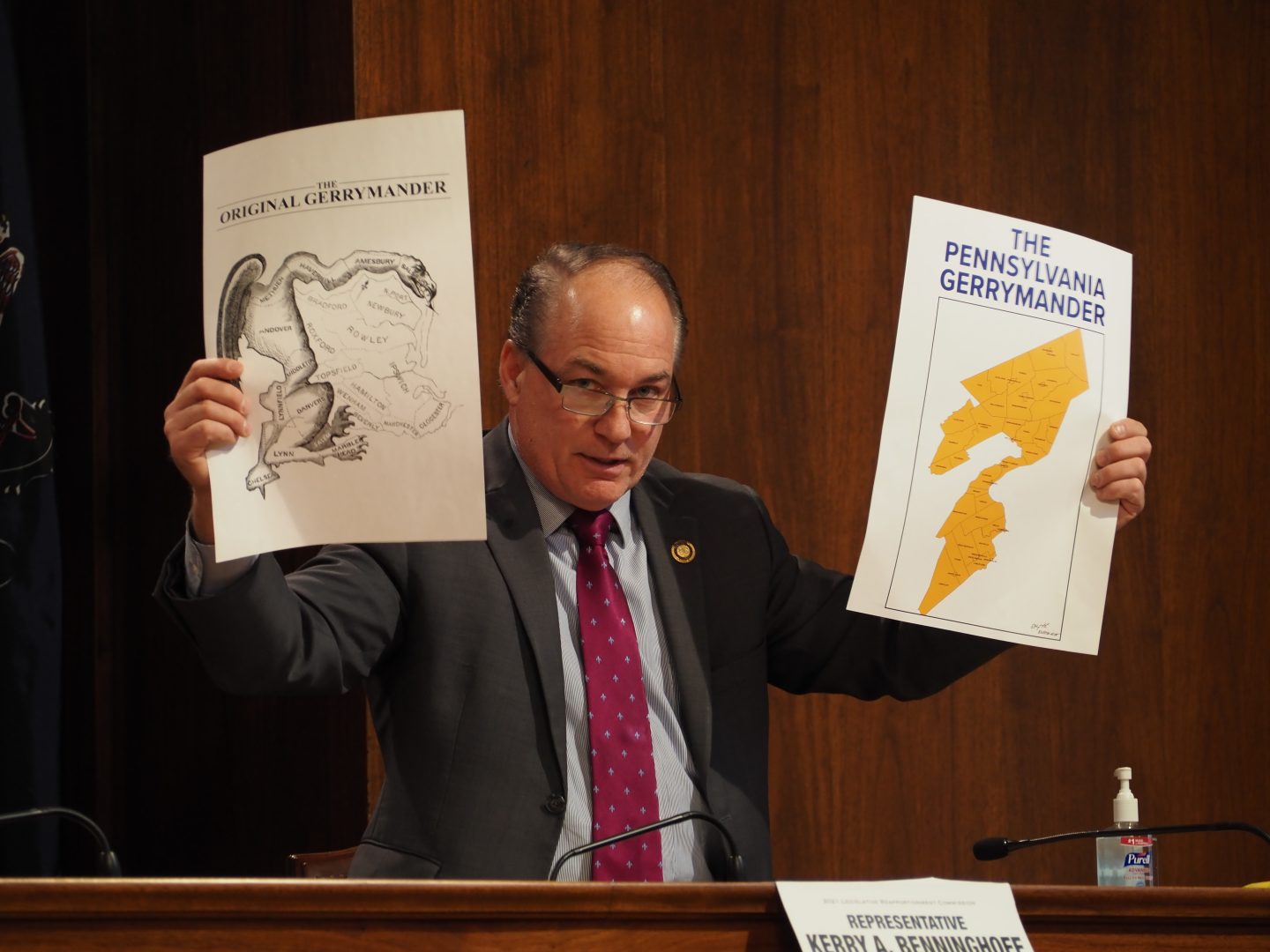
House Majority Leader Kerry Benninghoff (R-Centre) holds up a map of a proposed state House district and compares it to another political cartoon demonstrating a "well-fed lizard" gerrymander on at an LRC meeting on Dec. 16, 2021
Sam Dunklau / WITF

House Majority Leader Kerry Benninghoff (R-Centre) holds up a map of a proposed state House district and compares it to another political cartoon demonstrating a "well-fed lizard" gerrymander on at an LRC meeting on Dec. 16, 2021
Sam Dunklau / WITF

Sam Dunklau / WITF
House Majority Leader Kerry Benninghoff (R-Centre) holds up a map of a proposed state House district and compares it to another political cartoon demonstrating a "well-fed lizard" gerrymander on at an LRC meeting on Dec. 16, 2021
(Harrisburg) — An effort to reflect the rapid growth of Pennsylvania’s Hispanic population in newly drawn districts for the state’s predominantly white state Legislature is drawing criticism that it didn’t exactly accomplish that mission.
Instead, proposals from the five-member Legislative Reapportionment Commission that must reflect a decade of demographic changes identified by the census actually narrowed opportunities for Latinos, critics say.
The commission — composed of the Legislature’s four partisan floor leaders and a chair picked by the Democratic-majority state Supreme Court — voted Dec. 16 in favor of new preliminary maps, starting a 30-day public comment period.
The commission could make changes before it issues final maps, and Victor Martinez — who testified twice during commission hearings this year — said it should.
When Martinez testified, he urged commission members to create districts that reflect the growth of Pennsylvania’s Spanish-speaking population.
However, Martinez, who owns Spanish-language radio stations in markets across eastern Pennsylvania, said the commission instead created more districts that favor minority candidates generally, but not necessarily Latino candidates.
“You might have made it more inclusive, but as far as my testimony, as far as the people who I represent and the people I testified for, they didn’t do us any good, they didn’t make it any easier,” Martinez said in an interview.
Out of 1.5 million Hispanic or multiracial Hispanic residents in Pennsylvania, or almost 12%, just four Latinos serve in the 253-seat Legislature, Martinez said.
That’s under 2%. Proportional representation would be more like 29 seats.
The commission chair, former University of Pittsburgh chancellor Mark Nordenberg, describes the new maps as being drawn with eight “minority opportunity” districts that are particularly attractive because no incumbents live in those districts.
Seven are in the House and one is in the Senate.
However, only one has a majority Latino population. That district, the Allentown-based 22nd House district, actually shrinks the Latino population from the current 22nd, Martinez said.
Even an existing Latino-majority district in Reading went from 60% Latino to 50% Latino, Martinez said.
Pennsylvania’s shrinking white population and growing Hispanic population is relatively extraordinary.
It is just one of four states — Connecticut, Louisiana and Rhode Island are the others — that would have lost population over the past decade if it weren’t for Hispanic population gains, according to census figures.
Four metropolitan areas — Pittsburgh, Reading, Allentown-Bethlehem-Easton and Scranton-Wilkes-Barre — also would have lost population but for new Hispanic residents. It’s the same for seven counties: Berks, Lackawanna, Lehigh, Luzerne, Pike, Snyder and Washington.
All told, Pennsylvania’s white population dropped by about 540,000, or 5%, according to census figures, even as Pennsylvania’s population grew by 300,000 to 13 million, or 2%.
At the same time, Pennsylvania’s Hispanic and multiracial Hispanic population grew by 500,000, or 50%.
Carol Kuniholm, the chair of Fair Districts PA, a nonpartisan project of the League of Women Voters of Pennsylvania, complimented the proposed House map. But she attacked its Senate counterpart as a product of “buddy-mandering” that protects incumbents.
A newly drawn Senate district that absorbs most of Allentown actually has fewer Latino residents than the existing district that includes Allentown, Kuniholm said.
It also splinters a corridor connecting fast-growing Latino communities through cities including Easton, Bethlehem, Allentown and Reading — the Route 222 corridor — so that it can provide a safer district for Allentown’s current senator, Republican Pat Browne, Kuniholm said.
“The one they drew makes no sense to anybody,” Kuniholm said in an interview.
Kuniholm’s organization proposed a new Latino-majority district with no incumbent senator in Philadelphia. The commission’s proposed Senate map, however, split that community four ways among four incumbents, Kuniholm said.
Republicans hold majorities in both chambers, including 142 of 253 seats while representing the vast majority of the whitest stretches across Pennsylvania where the population is stagnant.
Nordenberg gave principal credit to House Democrats and Senate Republicans for drawing “minority opportunity” districts into the maps.
House Minority Leader Joanna McClinton, D-Philadelphia, and Senate Majority Leader Kim Ward, D-Westmoreland, both declined interviews about those districts.
In the House, Republicans are criticizing the proposed map as an unconstitutional gerrymander that stands to shrink their majority.
At the Dec. 16 commission meeting, McClinton lauded the House map that as being “representative” of Pennsylvania while substantially correcting decades of gerrymandering.
Ward said the Senate’s map needs corrections but did not elaborate.
In a text message, Ward suggested the proposed new Allentown district can be improved by giving it more Latino residents. She would not say how she plans to do it.
___
Follow Marc Levy on Twitter at www.twitter.com/timelywriter

Get insights into WITF’s newsroom and an invitation to join in the pursuit of trustworthy journalism.
The days of journalism’s one-way street of simply producing stories for the public have long been over. Now, it’s time to find better ways to interact with you and ensure we meet your high standards of what a credible media organization should be.